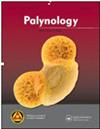Palynology of the Triassic–Jurassic transition of the Danish Basin (Denmark): a palynostratigraphic zonation of the Gassum–lower Fjerritslev formations
IF 1.3
4区 地球科学
Q3 PALEONTOLOGY
引用次数: 1
Abstract
Abstract The Upper Triassic–Lower Jurassic succession in the Danish Basin is penetrated by many deep wells that were drilled during former hydrocarbon exploration campaigns, but it is today targeted for geothermal energy and storage of CO2. The Stenlille salt dome on Sjælland sandstones of the Gassum Formation, sealed by the overlying Fjerritslev Formation mudstones, has been used for decades as a seasonal storage for natural gas. With its comprehensive dataset of seismics, geophysical well logs and conventional core data from 20 wells, the Stenlille succession serves as a model for other salt domes currently being evaluated as potential CO2 storage sites in the basin. Over the last decade the cored Triassic–Jurassic boundary succession has contributed to the understanding of environmental and palynological events during the end-Triassic mass extinction. Core, sidewall core and cutting samples from several of the closely situated Stenlille wells are here used to establish a high-resolution palynostratigraphic zonation scheme covering the entire Rhaetian to Sinemurian succession by integrating new analyses with previously published data. The palynological dataset has allowed the recognition of nine formally described spore-pollen zones, of which eight are new, while two previously described dinoflagellate cyst zones are subdivided into three informal subzones each. The palynological zonation is integrated with a sequence stratigraphic framework and will form the basis for the dating of future well sections in the Danish Basin and other basins and for correlation to outcrops. The large palynological dataset further shows that the vegetation around the Danish Basin was remarkably stable during the early to middle Rhaetian, but that events related to the emplacement of the Central Atlantic Magmatic Province accelerated ecosystem changes for c. 175 ky in the late Rhaetian and earliest Hettangian, including ∼25 ky of successional recovery before the terrestrial ecosystem had again stabilised.丹麦盆地三叠纪-侏罗纪过渡的孢粉学(丹麦):Gassum-下Fjerritslev地层的孢粉学分带
丹麦盆地的上三叠统-下侏罗统在以前的油气勘探活动中钻探了许多深井,但现在的目标是地热能和二氧化碳储存。位于Sjælland Gassum组砂岩上的Stenlille盐丘,被上覆的Fjerritslev组泥岩封闭,几十年来一直被用作季节性天然气储库。Stenlille连续层拥有20口井的地震、地球物理测井和常规岩心数据的综合数据集,可以作为盆地其他盐丘的模型,目前这些盐丘正在被评估为潜在的二氧化碳储存地点。在过去的十年中,三叠纪-侏罗纪边界的岩心演替有助于了解三叠纪末大灭绝期间的环境和孢粉事件。通过将新的分析结果与先前发表的数据相结合,研究人员利用位于邻近的Stenlille井的岩心、侧壁岩心和岩屑样品,建立了覆盖整个Rhaetian到Sinemurian演替的高分辨率孢球地层分带方案。孢粉学数据集允许识别9个正式描述的孢子-花粉区,其中8个是新的,而两个先前描述的鞭毛藻囊肿区被细分为三个非正式的亚区。孢粉分带与层序地层格架相结合,将成为丹麦盆地和其他盆地未来井段测年以及与露头对比的基础。大型孢粉学数据进一步表明,丹麦盆地周围的植被在雷地早期至中期非常稳定,但与中大西洋岩浆省的侵位有关的事件加速了雷地晚期和最早的Hettangian约175 ky的生态系统变化,包括在陆地生态系统再次稳定之前的约25 ky的连续恢复。
本文章由计算机程序翻译,如有差异,请以英文原文为准。
求助全文
约1分钟内获得全文
求助全文
来源期刊

Palynology
地学-古生物学
CiteScore
3.40
自引率
26.70%
发文量
48
审稿时长
>12 weeks
期刊介绍:
Palynology is an international journal, and covers all aspects of the science. We accept papers on both pre-Quaternary and Quaternary palynology and palaeobotany. Contributions on novel uses of palynology, review articles, book reviews, taxonomic studies and papers on methodology are all actively encouraged.
 求助内容:
求助内容: 应助结果提醒方式:
应助结果提醒方式:


